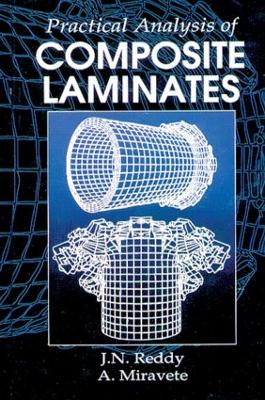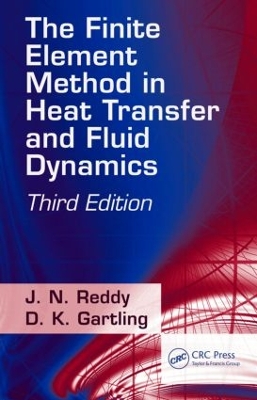Applied and Computational Mechanics
1 primary work • 6 total works
Book 1
Practical Analysis of Composite Laminates
by J. N. Reddy and Antonio Miravete
The Finite Element Method in Heat Transfer and Fluid Dynamics
by J. N. Reddy and D.K. Gartling
As Computational Fluid Dynamics (CFD) and Computational Heat Transfer (CHT) evolve and become increasingly important in standard engineering design and analysis practice, users require a solid understanding of mechanics and numerical methods to make optimal use of available software. The Finite Element Method in Heat Transfer and Fluid Dynamics, Third Edition illustrates what a user must know to ensure the optimal application of computational procedures—particularly the Finite Element Method (FEM)—to important problems associated with heat conduction, incompressible viscous flows, and convection heat transfer.
This book follows the tradition of the bestselling previous editions, noted for their concise explanation and powerful presentation of useful methodology tailored for use in simulating CFD and CHT. The authors update research developments while retaining the previous editions’ key material and popular style in regard to text organization, equation numbering, references, and symbols.
This updated third edition features new or extended coverage of:
- Coupled problems and parallel processing
- Mathematical preliminaries and low-speed compressible flows
- Mode superposition methods and a more detailed account of radiation solution methods
- Variational multi-scale methods (VMM) and least-squares finite element models (LSFEM)
- Application of the finite element method to non-isothermal flows
- Formulation of low-speed, compressible flows
With its presentation of realistic, applied examples of FEM in thermal and fluid design analysis, this proven masterwork is an invaluable tool for mastering basic methodology, competently using existing simulation software, and developing simpler special-purpose computer codes. It remains one of the very best resources for understanding numerical methods used in the study of fluid mechanics and heat transfer phenomena.
Another important feature of this book is its use of both traditional and SI units. Many examples through the text are worked in both sets of units. The data and results for every example are also shown in both types of units.
Mechanics of Solids is intended for use in a first course in mechanics of solids offered to undergraduates. An Instructor's Manual containing solutions to every problem in the book is available.
Computational Modeling of Polymer Composites: A Study of Creep and Environmental Effects details the development of polymeric materials and their use in smart materials and composite structures in aerospace and automotive industries. Based on the authors' work during the past 30 years, this book provides a strong understanding of the theories and associated finite element life-prediction models for elastic and viscoelastic response of polymers and polymer composites in aggressive environments. The subject is an interdisciplinary one where chemists, material scientists, and chemical, mechanical, and structural engineers contribute to the overall product.
Books on polymer composites are usually of three types: material science, mechanics, and computational. This book combines mechanics of materials with the computational element. The authors suggest an introductory course on mechanics of materials to cover all bases. The book begins with mathematical preliminaries, equations of anisotropic elasticity, virtual work principles, and variational methods. It provides an introduction to the finite element method and finite element analysis of viscoelastic materials, and then moves on to the solvent diffusion process in polymers and polymeric composites, as well as the linear and nonlinear viscoelastic models and the implementation of finite element models of viscoelastic materials.
Computational Modeling of Polymer Composites: A Study of Creep and Environmental Effects delves into both uniaxial and multiaxial cases and delayed failure before discussing the finite element analysis of the nonlinear diffusion process in polymers. It also includes non-Fickean diffusion of polymers, the coupled hygrothermal cohesive layer model for simulating debond growth in bimaterial interfaces, and the viscoelastic cohesive layer model for the prediction of interlaminar shear strength of carbon/epoxy composites. The final chapter covers a multi-scale viscoelastic cohesive layer model for predicting delamination in high temperature polymer composites. This book can be used as a reference or as a graduate course textbook on theory and/or finite element analysis of polymers and polymeric composites.
The Finite Element Method in Heat Transfer and Fluid Dynamics, Second Edition
by J. N. Reddy and D.K. Gartling
The award-winning first edition of The Finite Element Method in Heat Transfer and Fluid Dynamics brought this powerful methodology to those interested in applying it to the significant class of problems dealing with heat conduction, incompressible viscous flows, and convection heat transfer. The Second Edition of this bestselling text continues to provide the academic community and industry with up-to-date, authoritative information on the use of the finite element method in the study of fluid mechanics and heat transfer. Extensively revised and thoroughly updated, new and expanded material includes discussions on difficult boundary conditions, contact and bulk nodes, change of phase, weighted-integral statements and weak forms, chemically reactive systems, stabilized methods, free surface problems, and much more.
The Finite Element Method in Heat Transfer and Fluid Dynamics offers students a pragmatic treatment that views numerical computation as a means to an end and does not dwell on theory or proof. Mastering its contents brings a firm understanding of the basic methodology, competence in using existing simulation software, and the ability to develop some simpler, special purpose computer codes.
Computational Methods in Engineering: Finite Difference, Finite Volume, Finite Element, and Dual Mesh Control Domain Methods provides readers with the information necessary to choose appropriate numerical methods to solve a variety of engineering problems. Explaining common numerical methods in an accessible yet rigorous manner, the book details the finite element method (FEM), finite volume method (FVM) and importantly, a new numerical approach, dual mesh control domain method (DMCDM).
Numerical methods are crucial to everyday engineering. The book begins by introducing the various methods and their applications, with example problems from a range of engineering disciplines including heat transfer, solid and structural mechanics, and fluid mechanics. It highlights the strengths of FEM, with its systematic procedure and modular steps, and then goes on to explain the uses of FVM. It explains how DMCDM embodies useful parts of both FEM and FVM, particularly in its use of the control domain method and how it can provide a comprehensive computational approach. The final chapters look at ways to use different numerical methods, primarily FEM and DMCDM, to solve typical problems of bending of beams, axisymmetric circular plates, and other nonlinear problems.
This book is a useful guide to numerical methods for professionals and students in all areas of engineering and engineering mathematics.





